




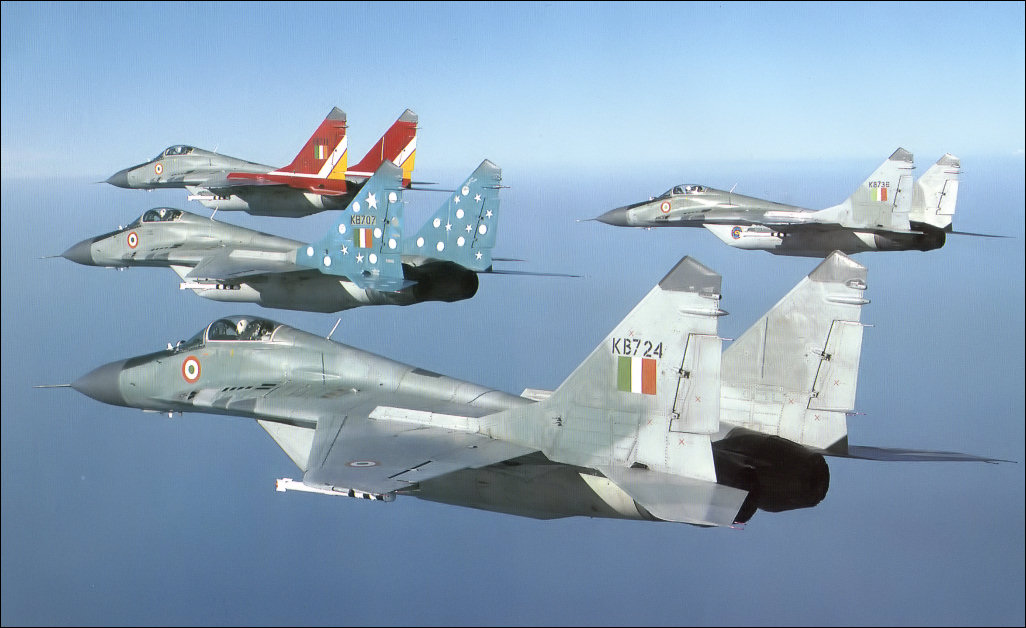


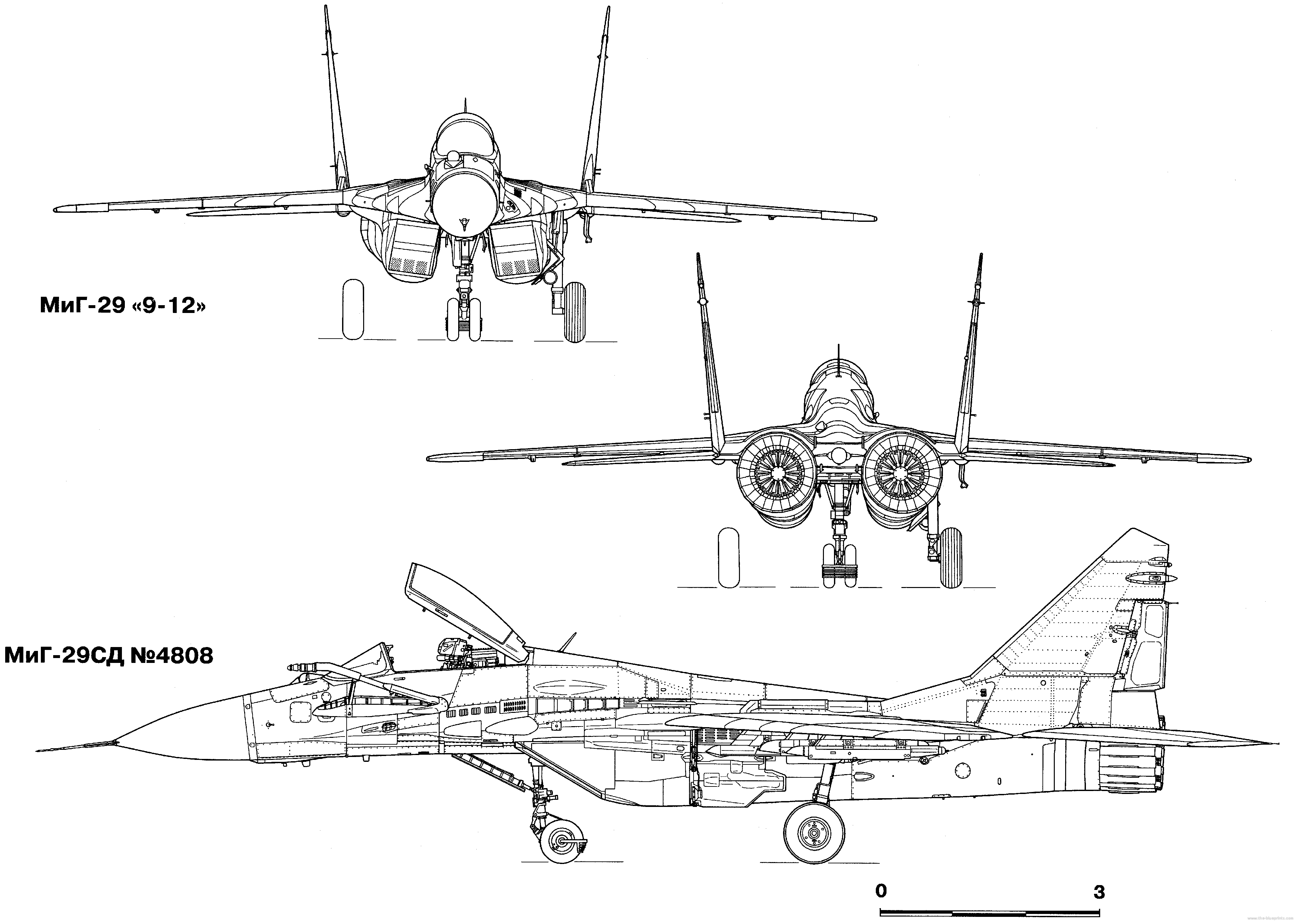

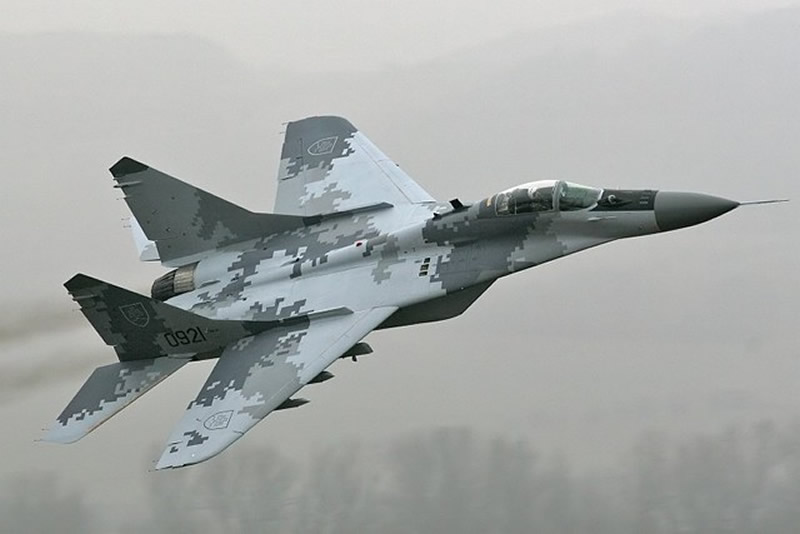
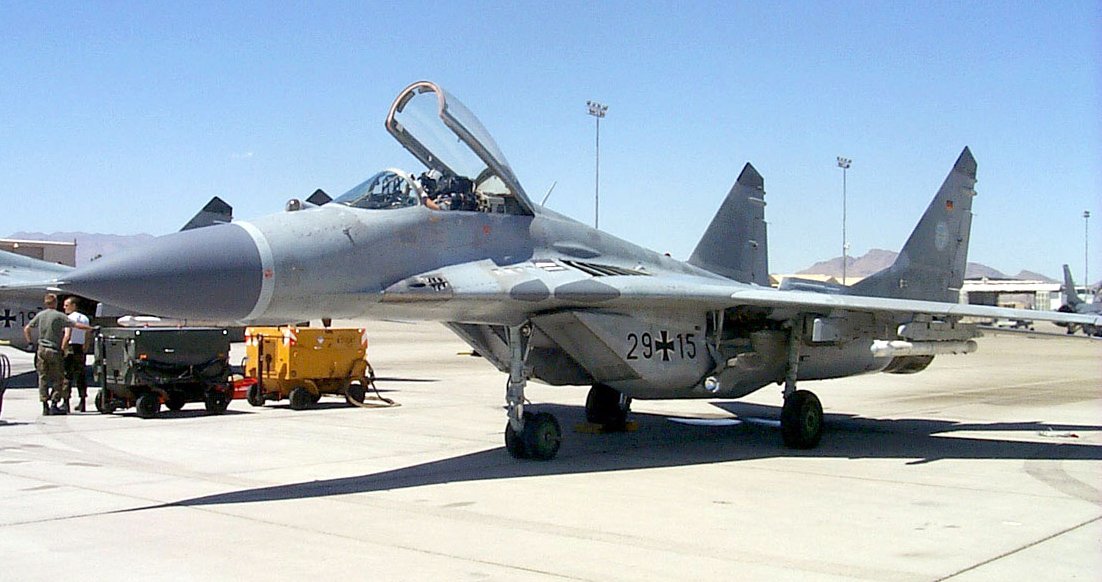
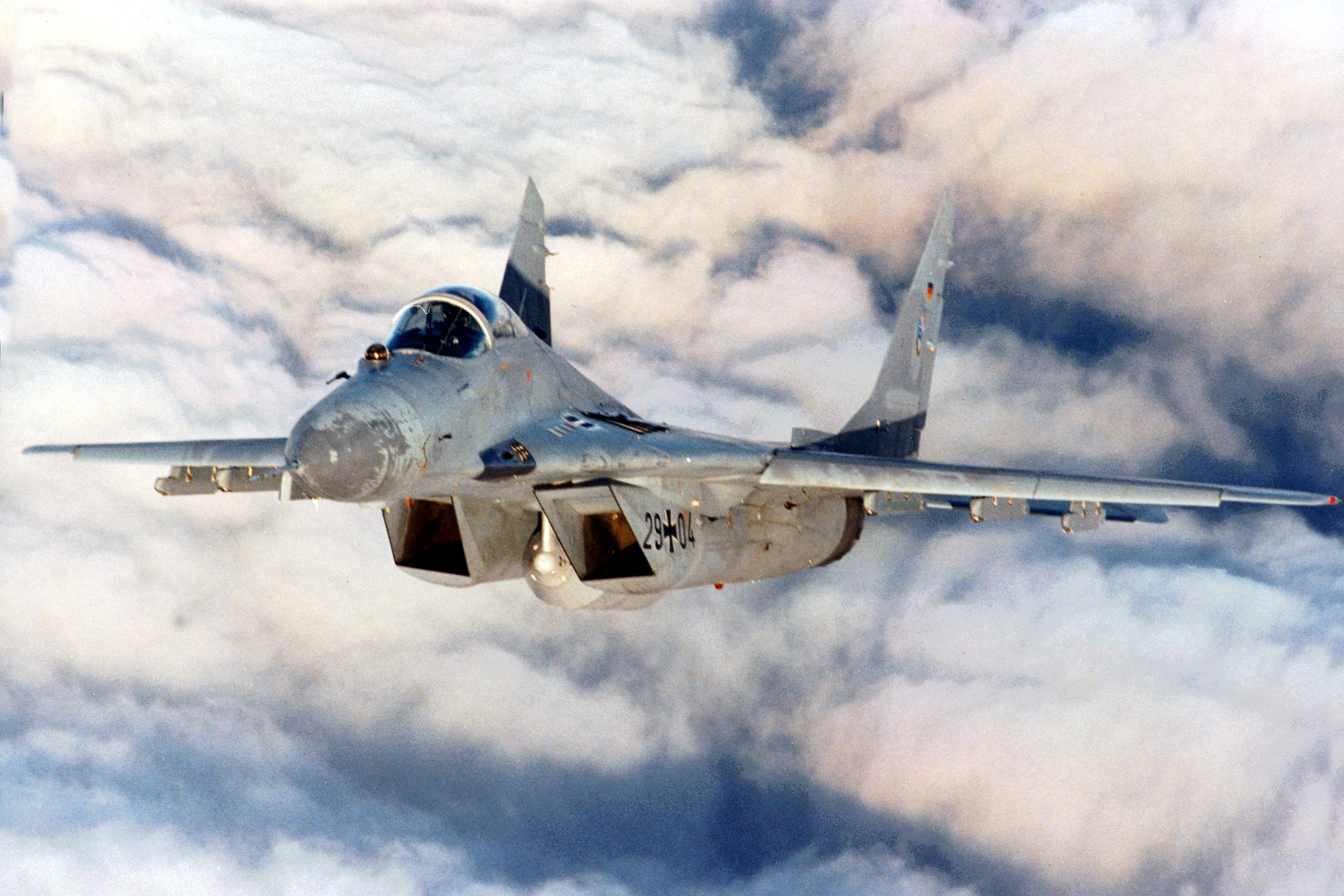
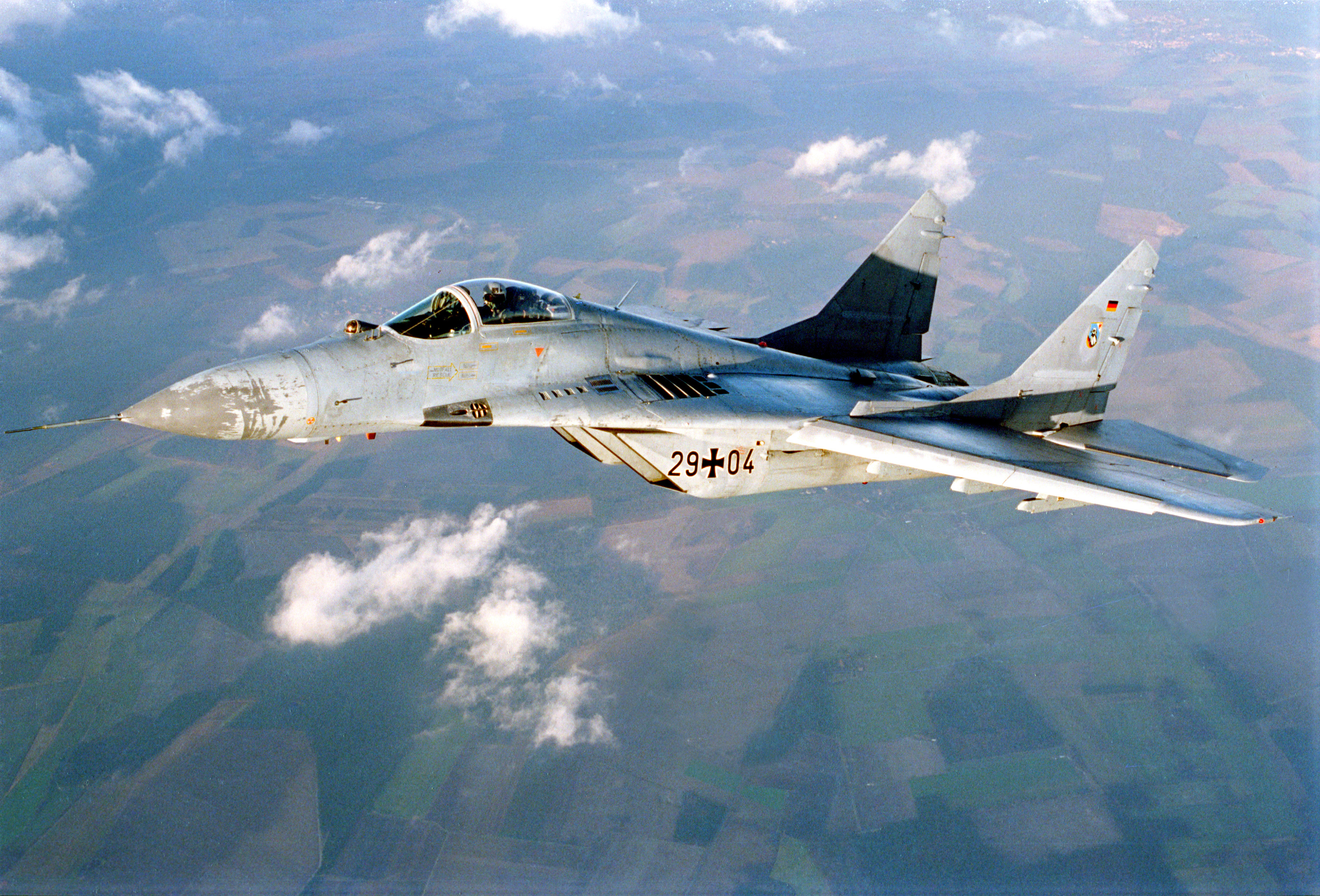
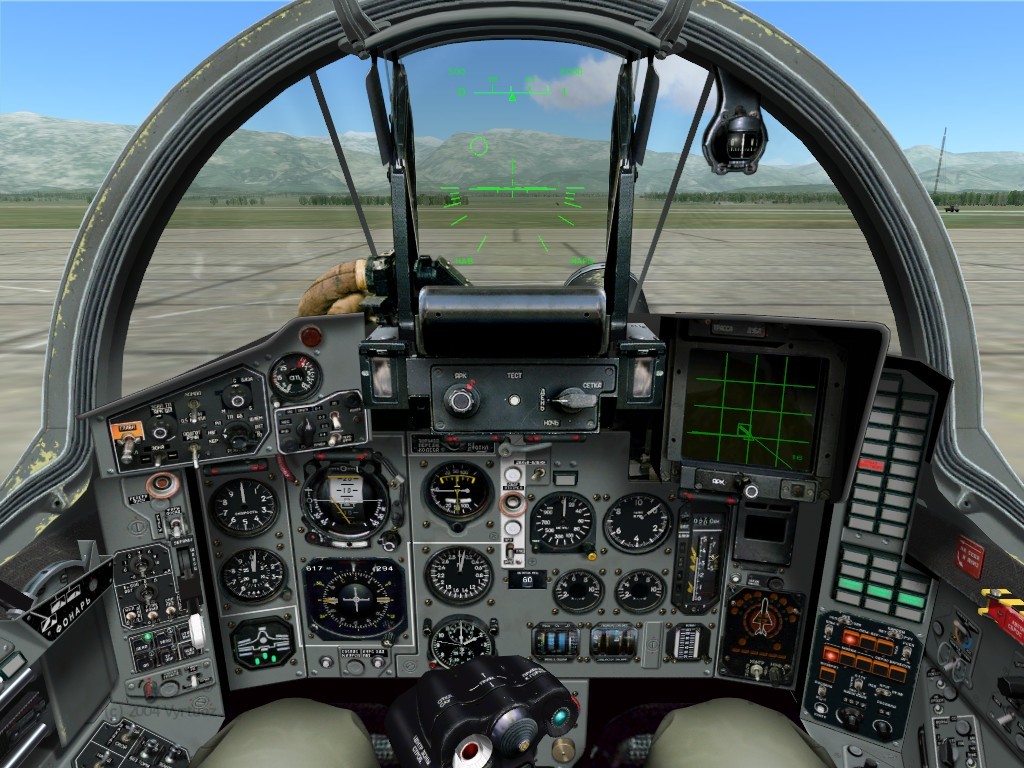

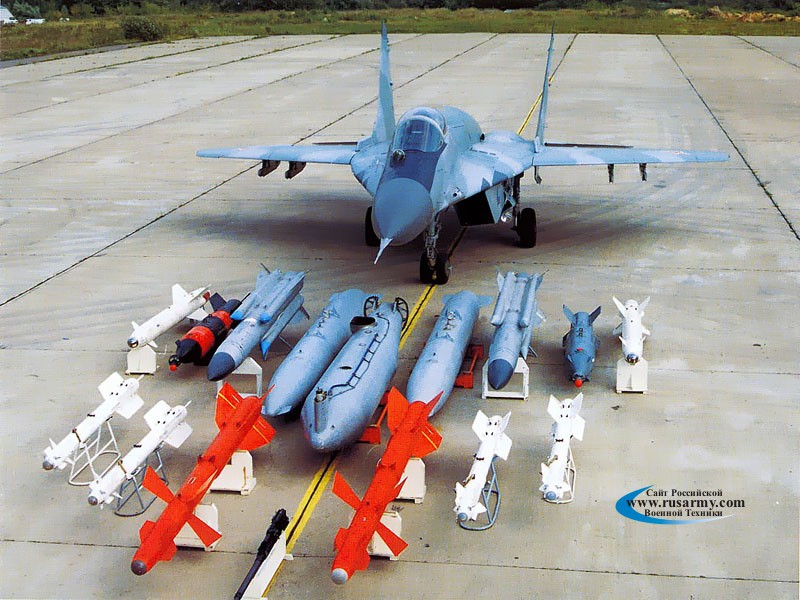

Mikoyan MiG-29
From Wikipedia, the free encyclopedia
"MiG-29" redirects here. For other uses, see MiG-29 (disambiguation).
| MiG-29 | |
|---|---|
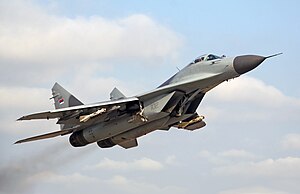 |
|
| Serbian Air Force and Air Defence MiG-29 takeoff | |
| Role | Air superiority fighter, multirole fighter |
| National origin | Soviet Union Russia |
| Manufacturer | Mikoyan |
| First flight | 6 October 1977 |
| Introduction | July 1983 |
| Status | In service |
| Primary users | Russian Air Force Indian Air Force Ukrainian Air Force Syrian Air Force See Operators below for others |
| Produced | 1982–present |
| Number built | 1,600+[1] |
| Unit cost | |
| Variants | Mikoyan MiG-29M Mikoyan MiG-29K Mikoyan MiG-35 |
While originally oriented towards combat against any enemy aircraft, many MiG-29s have been furnished as multirole fighters capable of performing a number of different operations, and are commonly outfitted to use a range of air-to-surface armaments and precision munitions. The MiG-29 has been manufactured in several major variants, including the multirole Mikoyan MiG-29M and the navalised Mikoyan MiG-29K; the most advanced member of the family to date is the Mikoyan MiG-35. Later models frequently feature improved engines, glass cockpits with HOTAS-compatible flight controls, modern radar and IRST sensors, considerably increased fuel capacity; some aircraft have also been equipped for aerial refuelling.
Following the dissolution of the Soviet Union, a number of successor states have continued to operate the MiG-29; the largest of which is the Russian Air Force. The Russian Air Force wanted to upgrade its existing fleet to the modernised MiG-29SMT configuration, but financial difficulties have limited deliveries. The MiG-29 has also been a popular export aircraft; more than 30 nations either operate or have operated the aircraft to date, India being one of the largest export operators of the type. As of 2013, the MiG-29 is in production by Mikoyan, a subsidiary of United Aircraft Corporation (UAC) since 2006.
Contents
Development
Origins
In the late 1960s, the United States Air Force started the "F-X" program, which led to the McDonnell Douglas F-15 Eagle being ordered for production in late 1969.[7] At the height of the Cold War, a Soviet response was necessary to avoid the possibility of a new American fighter gaining a serious technological advantage over existing Soviet fighters. Thus the development of a new air superiority fighter became a priority.[6] In 1969, the Soviet General Staff issued a requirement for a Perspektivnyy Frontovoy Istrebitel (PFI, translating directly as "Perspective Frontline Fighter", roughly "Advanced Frontline Fighter").[8] Specifications were extremely ambitious, calling for long range, good short-field performance (including the ability to use austere runways), excellent agility, Mach 2+ speed, and heavy armament. The Russian aerodynamics institute TsAGI worked in collaboration with the Sukhoi design bureau on the aircraft's aerodynamics.[8]By 1971, however, 1971 Soviet studies determined the need for different types of fighters. The PFI program was supplemented with the LPFI (Perspektivnyy Lyogkiy Frontovoy Istrebitel, or "Advanced Lightweight Tactical Fighter") program; the Soviet fighter force was planned to be approximately 33% PFI and 67% LPFI.[9] PFI and LPFI paralleled the USAF's decision that created the "Lightweight Fighter" program and the General Dynamics F-16 Fighting Falcon and Northrop YF-17.[10] The PFI fighter was assigned to Sukhoi, resulting in the Sukhoi Su-27, while the lightweight fighter went to Mikoyan. Detailed design work on the resultant Mikoyan Product 9, designated MiG-29A, began in 1974, with the first flight taking place on 6 October 1977. The pre-production aircraft was first spotted by United States reconnaissance satellites in November of that year; it was dubbed Ram-L because it was observed at the Zhukovsky flight test center near the town of Ramenskoye.[11][12]
The workload split between TPFI and LPFI became more apparent as the MiG-29 filtered into front line service with the Soviet Air Forces (Russian: Voenno-Vozdushnye Sily [VVS]) in the mid-1980s. While the heavy, long range Su-27 was tasked with the more exotic and dangerous role of deep air-to-air sweeps of NATO high-value assets, the smaller MiG-29 directly replaced the MiG-23 in the frontal aviation role. Features such as rugged landing gear and protective intake grates allowed MiG-29 operations from damaged or under-prepared airstrips that Soviet war planners expected to encounter during a rapid armored advance.[citation needed]
Introduction and improvements
In the West, the new fighter was given the NATO reporting name "Fulcrum-A" because the pre-production MiG-29A, which should have logically received this designation, remained unknown in the West at that time. The Soviet Union did not assign official names to most of its aircraft, although nicknames were common. Unusually, some Soviet pilots found the MiG-29’s NATO reporting name, "Fulcrum", to be a flattering description of the aircraft’s intended purpose, and it is sometimes unofficially used in Russian service.[13]The MiG-29B was widely exported in downgraded versions, known as MiG-29B 9-12A and MiG-29B 9-12B for Warsaw Pact and non-Warsaw Pact nations respectively, with less capable avionics and no capability for delivering nuclear weapons. Total production was about 840 aircraft.[citation needed]
In the 1980s, Mikoyan developed the improved MiG-29S to use longer range R-27E and R-77 air-to-air missiles. It added a dorsal 'hump' to the upper fuselage to house a jamming system and some additional fuel capacity. The weapons load was increased to 4,000 kg (8,800 lb) with airframe strengthening. These features were included in new-built fighters and upgrades to older MiG-29s.[14][15]
Refined versions of the MiG-29 with improved avionics were fielded by the Soviet Union, but Mikoyan’s multirole variants, including a carrier-based version designated MiG-29K, were never produced in large numbers. Development of the MiG-29K carrier version was suspended for over a decade before being resumed, the type went into service with the Indian Navy's INS Vikramaditya, and Russian Navy's Admiral Kuznetsov class aircraft carrier.
In the post-Soviet era, MiG-29 development was influenced by the Mikoyan bureau's apparent lesser political clout than rival Sukhoi.[citation needed] Mikoyan had developed improved versions of the MiG-29, called MiG-29M/M2 and MiG-29SMT. On 15 April 2014, the Russian Air Force placed an order for a batch of 16 MiG-29 SMT fighters.[16]
Replacement
On 11 December 2013, Russian deputy prime minister Dmitry Rogozin revealed that Russia is planning to build a new fighter to replace the MiG-29. Fighters like the Sukhoi Su-27 and its derivatives are to be replaced in Russian service by the Sukhoi PAK FA, but a different design is needed to replace the lighter MiGs. A previous attempt to develop a MiG-29 replacement, the MiG 1.44 demonstrator, failed in the 1990s. The concept came up again in 2001 with interest from India, but they later opted for a variant of the PAK FA. The lightweight fighter will be cheaper and easier to maintain than the PAK FA, while still able to match the performance of larger and heavier aircraft. Air Force commanders have hinted at the possibility of an single-engine airframe that uses the PAK FA's engine, radar, and weapons. Though primarily for Russian service, export opportunities are possible, as heavier planes like to PAK FA have been harder to sell before. It is currently unknown who will design and manufacture the proposed fighter.[17][18]Design
Overview
The MiG-29 has hydraulic controls and a SAU-451 three-axis autopilot but, unlike the Su-27, no fly-by-wire control system. Nonetheless, it is very agile, with excellent instantaneous and sustained turn performance, high-alpha capability, and a general resistance to spins. The airframe consists primarily of aluminum with some composite materials, and is stressed for up to 9-g (88 m/s²) maneuvers. The controls have "soft" limiters to prevent the pilot from exceeding g and alpha limits, the limiters can be disabled manually[19]
Powerplant and range
Main article: Klimov RD-33
The MiG-29 has two widely spaced Klimov RD-33 turbofan engines, each rated at 50.0 kN (11,240 lbf) dry and 81.3 kN (18,277 lbf) in afterburner. The space between the engines generates lift, thereby reducing effective wing loading, hence improving maneuverability. The engines are fed through wedge-type intakes fitted under the leading-edge extensions (LERXs), which have variable ramps to allow high-Mach
speeds. As an adaptation to rough-field operations, the main air inlet
can be closed completely and alter using the auxiliary air inlet on the
upper fuselage for takeoff, landing and low-altitude flying, preventing ingestion of ground debris.
Thereby the engines receive air through louvers on the LERXs which open
automatically when intakes are closed. However the latest variant of
the family, the MiG-35,
eliminated these dorsal louvers, and adopted the mesh screens design in
the main intakes, similar to those fitted to the Su-27.[20]The MiG-29 has a ferry range of 1,500 km without external fuel tanks, and 2,100 km with external tanks.[21] The internal fuel capacity of the original MiG-29B is 4,365 litres distributed between six internal fuel tanks, four in the fuselage and one in each wing. For longer flights, this can be supplemented by a 1,500-litre (330 Imp gal, 395 US gal) centreline drop tank and, on later production batches, two 1,150-litre (253 Imp gal, 300 US gal) underwing drop tanks. In addition, a small number have been fitted with port-side inflight refueling probes, allowing much longer flight times by using a probe-and-drogue system.[citation needed]
Cockpit
The cockpit features a conventional centre stick and left hand throttle controls. The pilot sits in a Zvezda K-36DM zero-zero ejection seat which has had impressive performance in emergency escapes.The cockpit has conventional dials, with a head-up display (HUD) and a Shchel-3UM helmet mounted display, but no HOTAS ("hands-on-throttle-and-stick") capability. Emphasis seems to have been placed on making the cockpit similar to the earlier MiG-23 and other Soviet aircraft for ease of conversion, rather than on ergonomics. Nonetheless, the MiG-29 does have substantially better visibility than most previous Russian jet fighters, thanks to a high-mounted bubble canopy. Upgraded models introduce "glass cockpits" with modern liquid-crystal (LCD) multi-function displays (MFDs) and true HOTAS.
Sensors
The baseline MiG-29B has a Phazotron RLPK-29 (Radiolokatsyonnui Pritselnui Kompleks) radar fire control system which includes the N019 (Sapfir 29; NATO: 'Slot Back') look-down/shoot-down coherent pulse-Doppler radar and the Ts100.02-02 digital computer. Tracking range against a fighter-sized target was only about 70 km (38 nmi) in the frontal aspect and 35 km (19 nmi) in the rear aspect.[citation needed]These performance deficiencies were largely due to the N019 radar not being a new design. Instead, the system was a further development of the architecture already used in Phazotron's Sapfir-23ML system, then in use on the MiG-23ML. During the initial MiG-29 design specification period in the mid-1970s, Phazotron NIIR was tasked with producing a modern radar for the MiG-29. To speed development, Phazotron based its new design on the work undertaken by NPO Istok on the experimental "Soyuz" radar program. Accordingly, the N019 was originally intended to have a flat planar array antenna and full digital signal processing, giving a detection and tracking range of at least 100 km against a fighter-sized target. Testing and prototypes soon revealed this could not be attained in the required timeframe, at least not in a radar that would fit in the MiG-29's nose. Rather than design a completely new, albeit more modest radar, Phazotron reverted to a version of the twisted-polarization Cassegrain antenna used successfully on the Sapfir-23ML to save time and cost. This system used the same analog signal processors as their earlier designs, coupled with a NII Argon-designed Ts100 digital computer. While this decision provided a working radar system for the new fighter, it inherited all of the weak points of the earlier design. This reliance on 1960s-era technology continued to plague the MiG-29's ability to detect and track airborne targets at ranges available with the R-27 and R-77 missiles, although new designs like the digital N010 Zhuk-M address the serious signal processing shortcomings inherent in the analog design. Most MiG-29 continue to use the analog N019 or N019M radar, although VVS has indicated its desire to upgrade all existing MiG-29s to a fully digital system.
The N019 was further compromised by Phazotron designer Adolf Tolkachev’s betrayal of the radar to the CIA, for which he was executed in 1986. In response to all of these problems, the Soviets hastily developed a modified N019M Topaz radar for the upgraded MiG-29S aircraft. However, VVS was reportedly still not satisfied with the performance of the system and demanded another upgrade. The latest upgraded aircraft offered the N010 Zhuk-M, which has a planar array antenna rather than a dish, improving range, and a much superior processing ability, with multiple-target engagement capability and compatibility with the Vympel R-77 (or RVV-AE) (NATO: AA-12 'Adder'). A useful feature the MiG-29 shares with the Su-27 is the S-31E2 KOLS, a combined laser rangefinder and IRST in an "eyeball" mount forward of the cockpit canopy.[citation needed]
Armament
Operational history
The Soviet Union exported MiG-29s to several countries. Because 4th-generation fighter jets require the pilots to have extensive training, air-defense infrastructure, and constant maintenance and upgrades, MiG-29s have had mixed operational history with different air forces.[22]Soviet Union and Russia
The MiG-29 was first publicly seen in the West when the Soviet Union displayed the aircraft in Finland in July 1986. Two MiG-29s were also displayed at the Farnborough Airshow in Britain in September 1988. The following year, the aircraft conducted flying displays at the 1989 Paris Air Show where it was involved in a non-fatal crash during the first weekend of the show.[23] The Paris Air Show display was only the second display of Soviet fighters at an international air show since the 1930s. Western observers were impressed by its apparent capability and exceptional agility. Following the disintegration of the Soviet Union, most of the MiG-29s entered service with the newly formed Russian Air Force.In 1993, two MiG-29s of the Russian Air Force collided in mid-air and crashed away from the public at the 1993 Royal International Air Tattoo (UK). No one was hurt on the ground.[24] The two pilots ejected and landed safely.[25]
On 20 April 2008, Georgian officials claimed a Russian MiG-29 shot down a Georgian Hermes 450 unmanned aerial vehicle and provided video footage from the ill-fated drone showing an apparent MiG-29 launching an air-to-air missile at it. Russia denies that the aircraft was theirs and says they did not have any pilots in the air that day. Abkhazia’s administration claimed its own forces shot down the drone with an L-39 aircraft "because it was violating Abkhaz airspace and breaching ceasefire agreements."[26] UN investigation concluded that the video was authentic and that the drone was shot down by a Russian MiG-29 or Su-27 using a R-73 heat seeking missile.[27]
The Russian Air Force grounded all its MiG-29s following a crash in Siberia on 17 October 2008.[28] Following a second crash with an MiG-29 in east Siberia in December 2008,[29][30] Russian officials admitted that most MiG-29 fighters in the Russian Air Force were incapable of performing combat duties due to poor maintenance. The age of the aircraft was also an important factor as about 70% of the MiGs were considered to be too old to take to the skies.[31] The Russian MiG-29s have not received updates since the collapse of the Soviet Union. This is because the Russian Air Force chose to upgrade the Su-27 and MiG-31 instead. On 4 February 2009, the Russian Air Force resumed flights with the MiG-29.[32] However, in March 2009, 91 MiG-29s of the Russian Air Force required repair after inspections due to corrosion; approximately 100 MiGs were cleared to continue flying at the time.[33][34] The Russian Air Force started an update of its early MiG-29s to the more current MiG-29SMT standard,[35] but financial difficulties prevented delivery of more than three MiG-29 SMT upgrade to the Russian Air Force.[36] Instead, the 35 MiG-29SMT/UBTs rejected by Algeria were bought by the Russian Air Force.[37][verification needed] Russia placed an order for 16 new-build MiG-29SMTs on 15 April 2014, with delivery expected by 2017.[38]
India
Indian MiG-29s were used extensively during the 1999 Kargil War in Kashmir by the Indian Air Force to provide fighter escort for Mirage 2000s, which were attacking targets with laser-guided bombs. According to Indian sources, two MiG-29s from the IAF's No. 47 squadron (Black Archers) gained missile lock on two F-16s of the Pakistan Air Force (PAF) which were patrolling close to the border to prevent any incursions by Indian aircraft, but did not engage them because no official declaration of war had been issued. The Indian MiG-29s were armed with beyond-visual-range air-to-air missiles whereas the Pakistani F-16s were not.[40]
The MiG-29’s good operational record prompted India to sign a deal with Russia in 2005—2006 to upgrade all of its MiG-29s for US$888 million. Under the deal, the Indian MiGs were modified to be capable of deploying the R-77RVV-AE (AA-12 'Adder') air-to-air missile. The missiles had been successfully tested in October 1998 and were integrated into IAF's MiG-29s. IAF has also awarded the MiG Corporation another US$900 million contract to upgrade all of its 69 operational MiG-29s. These upgrades will include a new avionics kit, with the N-109 radar being replaced by a Phazatron Zhuk-M radar. The aircraft is also being equipped to enhance beyond-visual-range combat ability and for air-to-air refuelling to increase endurance.[41] In 2007, Russia also gave India’s Hindustan Aeronautics Limited (HAL) a licence to manufacture 120 RD-33 series 3 turbofan engines for the upgrade.[42] The upgrade will also include a new weapon control system, cockpit ergonomics, air-to-air missiles, high-accuracy air-to-ground missiles and "smart" aerial bombs. The first six MiG-29s will be upgraded in Russia while the remaining 63 MiGs will be upgraded at the HAL facility in India. India also awarded a multi-million dollar contract to Israel Aircraft Industries to provide avionics and subsystems for the upgrade.[43]
In March 2009, the Indian Air Force expressed concern after 90 MiG-29s were grounded in Russia.[44] After carrying out an extensive inspection, the IAF cleared all MiG-29s in its fleet in March 2009.[45] In a disclosure in Parliament, Defence Minister A. K. Antony said the MiG-29 is structurally flawed in that it has a tendency to develop cracks due to corrosion in the tail fin. Russia has shared this finding with India, which emerged after the crash of a Russian Air Force MiG-29 in December 2008. "A repair scheme and preventive measures are in place and IAF has not encountered major problems concerning the issue," Antony said.[46] Despite concerns of Russia's grounding, India sent the first six of its 78 MiG-29s to Russia for upgrades in 2008. The upgrade program will fit the MiGs with a phased array radar (PESA) and in-flight re-fuelling capability.[22]
In January 2010, India and Russia signed a US$1.2 billion deal under which the Indian Navy would acquire 29 additional MiG-29Ks, bringing the total number of MiG-29Ks on order to 45.[47] The MiG-29K entered service with the Indian Navy on 19 February 2010.[48]
The upgrades to Indian MiG-29s will be to the MiG-29UPG standard. This version is similar to the SMT variant but differs by having a foreign-made avionics suite.[49] The upgrade to latest MiG-29UPG standard is in process, which will include latest avionics, Zhuk-ME Radar, engine, weapon control systems, enhancing multirole capabilities by many-fold.[50][51] As of 2012, Indian UPG version is the most advanced MiG-29 variant.[52] The Director-General of MiG, Sergei Korotkov said, "The most advanced is the MiG-29UPG, implemented in India in collaboration with local industry".[52] RAC MiG has upgraded the first six MiG-29UPG fighters for India by October 2012.[53] The first three aircraft were delivered in December 2012, over two years behind schedule.[54]
Yugoslavia and Serbia
Yugoslav MiG-29s saw little combat during the breakup of Yugoslavia, and were used primarily for ground attacks. Several Antonov An-2 aircraft used by Croatia were destroyed on the ground at Čepin airfield near Osijek, Croatia in 1991 by a Yugoslav MiG-29, with no MiG-29 losses.[56] At least two MiG-29 carried out an air strike on Banski dvori, the official residence of the Croatian Government, on 7 October 1991.[57]
The MiG-29s continued their service in the subsequent Federal Republic of Yugoslavia. Because of the United Nations arms embargo against the country, the condition of the MiG-29s worsened.[citation needed]
A total of six MiG-29s were shot down during the Kosovo War, of which three were shot down by USAF F-15s, one by a USAF F-16, and one by a RNAF F-16.[58] One aircraft, according to pilot, was hit by friendly fire from the ground.[59] Another four were destroyed on the ground.[60] Some Russian sources claim that a MiG-29 shot down an F-16 on 26 March 1999,[61] but this kill is disputed, as the F-16C in question was said to have crashed in the US that same day.[62]
Most historians attribute the downing of a F-117 as being shot down by SAM commander Zoltan Dani.[63] Russian sources have claimed a F-117 was shot down by a MiG-29[64][65][source needs translation][66][source needs translation][67][source needs translation][68][unreliable source?][69][unreliable source?] piloted by Lt. Gvozden Đukić, which was the nom de guerre of Zoltan Dani.[70][71][source needs translation]
The Air Force of Serbia and Montenegro continued flying its remaining five MiG-29s at a very low rate after the war. In spring 2004, news appeared that MiG-29 operations had ceased, because the aircraft could not be maintained.[56] The Serbian Air Force operates four MiG-29s as of 2014.[citation needed]
Germany
The German Democratic Republic (also known as East Germany) bought 24 MiG-29s (20 MiG-29As, four MiG-29UBs), which entered service in 1988–1989.[72] After the fall of the Berlin Wall in November 1989 and reunification of Germany in October 1990, the MiG-29s and other aircraft of the East German Air Forces of the National People's Army were integrated into the West German Luftwaffe.[citation needed]The Federation of American Scientists claims the MiG-29 is equal or better than the F-15C in some areas such as short aerial engagements because of the Helmet Mounted Weapons Sight (HMS) and better maneuverability at slow speeds.[73] This was demonstrated when MiG-29s of the German Air Force participated in joint DACT exercises with US fighters.[74][75] The HMS was a great help, allowing the Germans to achieve a lock on any target the pilot could see within the missile field of view, including those almost 45 degrees off boresight.[76] In contrast, the American aircraft were only able to lock on to targets in a narrow window directly in front of the aircraft’s nose.[citation needed] It was not until late 2003 that the USAF and US Navy achieved Initial Operational Capability of the Joint Helmet Mounted Cueing System.[citation needed]
Beginning in 1993 the German MiGs were stationed with 1./JG73 "Steinhoff" in Laage near Rostock. During the service in the German Air Force, one MiG-29 ("29+09") was destroyed during an accident on 25 June 1996 due to pilot error. By 2003, German Air Force pilots had flown over 30,000 hours in the MiG-29. In September 2003, 22 of the 23 remaining machines were sold to the Polish Air Force for the symbolic price of €1 per item.[77] The last aircraft were transferred in August 2004.[78] The 23rd MiG-29 ("29+03") was put on display at Laage.[79]
Poland
In 2004 Poland received 22 MiG-29s from the German Air Force. A total of 14 of these were overhauled and taken into service, equipping the 41st Tactical Squadron (41. elt) and replacing its MiG-21s. At present Poland has 32 active MiG-29s (26 MiG-29As, six MiG-29UB) which will serve at least until 2013–2015. They are currently stationed with the 1st Tactical Squadron at the 23rd Air Base near Mińsk Mazowiecki and the 41st TS at the 22nd Air Base near Malbork. As of 2008, Poland is the biggest NATO MiG-29 user. The possibility of modernising the fighters to enable them to serve until 2020–2025 is being contemplated, depending on whether cooperation with Mikoyan can be established.
There have been unconfirmed reports that Poland had at one point leased a MiG-29 from their own inventory to Israel for evaluation and the aircraft has since been returned to Poland, as suggested by photographs of a MiG-29 in Israeli use. Three Polish MiG-29A were reported in Israel for evaluation between April and May 1997 at Negev desert.[80] On 7 September 2011 the Polish Air Force awarded a contract to the WZL 2 company to modernise its MiG-29 fleet to be compatible with Polish F-16s.[81]
Four MiG-29s from 1. elt performed Baltic Air Policing Quick Reaction Alert mission in 2006, while 41. elt aircraft in 2008, 2010 and 2012. Polish MiG-29s played the aggressor role in NATO Tactical Leadership Programme (TLP) joint training program in Albacete, Spain in 2011, 2012 and 2013.[82]
United States
In 1997, the United States purchased 21 Moldovan aircraft under the Nunn–Lugar Cooperative Threat Reduction program. Fourteen were MiG-29Ss, which are equipped with an active radar jammer in its spine and are capable of being armed with nuclear weapons. Part of the United States’ motive to purchase these aircraft was to prevent them from being sold to "rogue states", especially Iran.[83] This purchase could also provide the United States Air Force with a working evaluation and data for the MiG-29, and possibly for use in dissimilar air combat training. Such information may prove valuable in any future conflicts and can aid in the design and testing of current and future weapons platforms. In late 1997, the MiGs were delivered to the National Air and Space Intelligence Center (NASIC) at Wright-Patterson Air Force Base in Ohio, though many of the former Moldovan MiG-29s are believed to have been scrapped.Iraq
Iraq received a number of MiG-29 fighters, and used MiG-29s to engage Iranian equivalent opponents during the later stages of the Iran-Iraq War.[citation needed]MiG-29s also saw combat in the 1991 Persian Gulf War with the Iraqi Air Force. Five MiG-29s were shot down by USAF F-15s.[84] Some Russian sources reported that at least one Panavia Tornado, ZA467, was shot down in northwestern Iraq by a MiG-29.[85][86] UK sources claim this Tornado to have crashed on 22 January on a mission to Ar Rutbah.[87] Other Iraqi air-to-air kills are reported in Russian sources, where the US claims other cases of combat damage, such as a B-52 which the US claims was hit by friendly fire, when an AGM-88 High-speed, Anti-Radiation Missile (HARM) homed on the fire-control radar of the B-52's tail gun; bomber was subsequently renamed "In HARM's Way".[88]
Iraq's original fleet of 37 MiG-29s was reduced to 12 after the Gulf War. One MiG-29 was damaged, and four were evacuated to Iran.[89] The remaining 12 aircraft were withdrawn from use in 1995 because the engines needed to be overhauled but Iraq could not send them off for that work.[90]
After the American-led 2003 invasion of Iraq and disbandment of the Ba'athist Iraqi Army in May of the same year,[91] the remaining Russian-made and Chinese-made fighters of Iraqi forces had been decommissioned, and to be replaced by recently ordered American-made F-16.[92]
Syria
Syrian Arab Air Force (SyAAF) MiG-29s have encountered several times with Israeli fighter and reconnaissance aircraft. Two Israeli F-15Cs are reported to have shot down two MiG-29As on 2 June 1989 under unclear circumstances.[93][94]Further reports claim that on 14 September 2001 two Syrian Air Force MiG-29s were shot down by two IDF/AF F-15C while the MiGs were intercepting an Israeli reconnaissance aircraft off the coast of Lebanon. However, both Syria and Israel deny that this occurred.[94][95][96]
During the 2013 phase of the Syrian civil war, Syrian Fulcrums entered the fray in late October, performing ground attack missions with unguided rockets and bombs against Free Syrian Army insurgents in the Damascus area.[97]
Sudan
There have been occasional claims regarding the use of Sudanese Air Force MiG-29s against insurgent forces in Darfur. However, whereas Mi-24 'Hind' combat helicopters as well as A-5 'Fantan' or, more recently, Su-25 "Frogfoot" ground-attack aircraft have been spotted and photographed on Darfurian air fields, no MiG-29s have been observed. On 10 May 2008, a Darfur rebel group, the Justice and Equality Movement (JEM) mounted an assault on the Sudanese capital. During this action, the JEM shot down a Sudanese Air Force MiG-29 with 12.7 mm and 14.5 mm heavy machine gun fire while it was attacking a convoy of vehicles in the Khartoum suburb of Omdurman. The aircraft was piloted by a Russian mercenary. He was killed in action as his parachute did not open after ejecting.[98][99][100]During the brief 2012 South Sudan–Sudan border conflict, on 4 April 2012, Sudan People's Liberation Army (SPLA) claimed the downing of a Sudanese MiG-29 using antiaircraft guns. The Sudan government denied the claim.[101] On 16 April 2012, the SPLA issued a second claim about the downing of a Sudanese MiG-29.[102] It was not clear if this second claim referred to the previous one.
North Korea
The Korean People's Air Force is believed to operate about 40 MiG-29Bs and MiG-29SEs divided into the 55th and 57th fighter regiments based at Sunchon and Onchon, respectively.[103] These were first encountered and photographed by the USAF in March 2003 when a pair of KPAF MiG-29s intercepted an USAF RC-135S reconnaissance aircraft.[104][verification needed]Other countries
According to some reports, in the 1999 Eritrean-Ethiopian War, three Eritrean MiG-29s were shot down by Ethiopian Su-27s piloted by Russian mercenaries.[106] There are also some other reports of Eritrean MiG-29s shooting down two Ethiopian MiG-21s, three MiG-23s, and an Su-25.[107]
Russia moved to expand its growing military influence in the Middle East when it announced it is giving Lebanon 10 fighter jets, in the most significant upgrade of Lebanon's military since the civil war ended almost two decades ago. Russia's defence ministry said it was giving the secondhand MiG-29s to Beirut free of charge. The gift was part of a defence cooperation deal that would see Moscow train Lebanese military personnel.[108]
Variants
There are currently several upgrade programmes conducted by the Russian Air Force for MiG-29 fighters which envisage: upgrading of the avionics suite to comply with NATO / ICAO (www.icao.int) standards, extension of the aircraft service life to 4,000 flight hours (40 years), upgrading combat capabilities and reliability, safety enhancements. In 2005 the Russian Aircraft Corporation “MiG” started production of new unified family of multirole fighters of the 4++ generation (aircraft-carrier–based MiG-29K, front-line MiG-29M and MiG-35 fighters).- MiG-29 (Product 9.12)
- Initial production version; entered service in 1983. NATO reporting code is "Fulcrum-A".
- MiG-29B-12 (Product 9.12A)
- Downgraded export version for Warsaw Pact (9.12A) and non-Warsaw Pact nations (9.12B). Lacked a nuclear weapon delivery system and possessed downgraded radar, ECM and IFF. NATO reporting code is "Fulcrum-A".
- MiG-29UB-12 (Product 9.51)
- Twin seat training model. Infra-red sensor mounted only, no radar. NATO reporting code is "Fulcrum-B".
- MiG-29S
- The MiG-29S, given the NATO reporting code "Fulcrum-C", features flight control system improvements; a total of four new computers provide better stability augmentation and controllability with an increase of 2° in angle of attack (AoA). An improved mechanical-hydraulic flight control system allows for greater control surface deflections. The MiG-29S has a dorsal hump, which led to its nickname "Fatback", houses the L-203BE Gardenyia-1 ECM system. The MiG-29S can carry 1,150 liter (304 US gallon, 2,000 lb) under wing drop tanks and a centerline tank. The inboard underwing hardpoints allow a tandem pylon arrangement for carrying a larger payload of 4,000 kg (8,820 lb). Overall maximum gross weight has been raised to 20,000 kg (44,000 lb).
- Changes to the armaments include new longer-range air-to-air missiles like the R-77 (AA-12 "Adder"); as well minor alterations to the cartridge ejection system of the GSh-30-1 cannon. Early MiG-29S featured an IRST sighting system; the MiG-29S improvement kit includes the Phazotron N019M radar and Built-In Test Equipment (BITE) to reduce dependence on ground support equipment; MiG MAPO designates this as MiG-29SD. Improvements to the MiG-29S's software and processing capabilities enables the tracking of up to 10 targets and the simultaneous engagement of two with the R-77 missile. The MiG-29S also has a limited ground-attack capability.
- MiG-29SE
- Export model MiG-29S except with slightly downgraded N-019ME radar with multiple target tracking ability and AAM-AE compatibility. The first export model MiG-29 with underwing drop tanks; the inner underwing pylons can carry over 500 kg bombs in side by side tandem pairs. Its weapons mix includes R-27T1, R-27ER1 and R-27ET1 medium-range missiles. The aircraft can be fitted with active ECM systems, weapons guidance aids, improved built-in check and training systems. The MiG-29SE can simultaneously engage two air targets.
- MiG-29S-13 (Product 9.13)
- MiG-29 variant similar to the 9.12, but with an enlarged fuselage spine containing additional fuel and a Gardeniya active jammer. Product 9.13S is also version with the same airframe as the 9.13, but with an increased external weapons load of 4,000 kg, and provision for two underwing fuel tanks. Radar upgraded to N019ME, providing an ability to track 10 targets and engage two simultaneously. Compatible with the Vympel R-77 (AA-12 "Adder") air-to-air missile (similar to the AIM-120 AMRAAM). NATO reporting code is "Fulcrum-C".
- MiG-29SM (Product 9.13M)
- Similar to the 9.13, but with the ability to carry guided air-to-surface missiles and TV- and laser-guided bombs. NATO reporting code is "Fulcrum-C".
- MiG-29G/MiG-29GT
- It was an upgrade standard for the German Air Force's MiG-29 / 29UB, inherited from the former East Germany to the NATO standards. Works was done by MiG Aircraft Product Support GmbH (MAPS), a joint venture company form between MiG Moscow Aviation Production Association and DaimlerChrysler Aerospace in 1993.[109]
- MiG-29AS/MiG-29UBS (MiG-29SD)
- Slovak Air Force performed an upgrade on their MiG-29/-29UB for NATO compatibility. Work is done by RAC MiG and Western firms, starting from 2005. The aircraft now has navigation and communications systems from Rockwell Collins, an IFF system from BAE Systems, new glass cockpit features multi-function LC displays and digital processors and also fitted to be integrate with Western equipment in the future. However, the armaments of the aircraft remain unchanged. 12 out of 21 of the entire MiG-29 fleet were upgraded and had been delivered as of late February 2008.[110]
- MiG-29 Sniper
- Upgrade planned for Romanian Air Force, by Israeli firms. First flight occurred on 5 May 2000. The program was halted along with the retiring of Romanian MiG-29s in 2003. The latter occurred because of high maintenance costs, which led to the Romanian Government's decision to halt the MiG-29 program and further invest in the MiG-21 LanceR program.
- MiG-29M / MiG-33 (Product 9.15)
Main article: Mikoyan MiG-29M
- Advanced multirole variant, with a redesigned airframe, mechanical flight controls replaced by a fly-by-wire system and powered by enhanced RD-33 ser.3M engines. NATO reporting code is "Fulcrum-E".
- MiG-29UBM (Product 9.61)
- Two-seat training variant of the MiG-29M. Never built. Effectively continued under the designation 'MiG-29M2'.
- MiG-29K (Product 9.31)
Main article: Mikoyan MiG-29K
- Naval variant based on MiG-29M, the letter "K" stands for "Korabelnogo bazirovaniya" (Deck-based ), with equipment such as folding wings, arrestor gear, and reinforced landing gear. Originally intended for the Admiral Kuznetsov class aircraft carriers, had even received series production approval from Russian Ministry of Defence but was later grounded in 1992 due to shift in military doctrine and state financial difficulty.[111] MiG Corporation restarted the program in 1999 and made vital improvement to the previous design. On 20 January 2004, Indian Navy signed a contract of 12 single-seat MiG-29K and four two-seat MiG-29KUB.[111] Modifications were made for Indian Navy requirement, now standard for all current production. Current production MiG-29K and MiG-29KUB also share a two-seater size canopy. The MiG-29K has radar absorbing coatings to reduce radar signature. Cockpit displays consist of wide HUD and three (seven on MiG-29KUB) colour LCD MFDs with a Topsight E helmet-mounted targeting system. It has a full range of weapons compatible with the MiG-29M and MiG-29SMT.[112] NATO reporting code is "Fulcrum-D".
- MiG-29KUB (Product 9.47)
- Identical characteristic to the MiG-29K but with tandem twin seat configuration. The design is to serve as trainer for MiG-29K pilot and is full combat capable. The first MiG-29KUB developed for the Indian Navy made its maiden flight at the Russian Zhukovsky aircraft test centre on 22 January 2007.[113] NATO reporting code is "Fulcrum-D".
- MiG-29SMT (Product 9.17)
- The MiG-29SMT is an upgrade package of the first-generation MiG-29s (9.12 to 9.13) containing many enhancements intended for the MiG-29M. Additional fuel tanks in a further enlarged spine provide a maximum flight range of 2,100 km (on internal fuel). The cockpit has an enhanced HOTAS design, two 152 × 203 mm (6 × 8-inch) colour liquid crystal MFDs and two smaller monochrome LCDs. MiG-29A is not designed to have advanced air-to-ground capability, this restricts MiG-29's capability and export potential, the SMT aims to upgrade air-to-ground capability to a higher standard. Key improvement is to equip air-to-ground detection featured radar, and to intergrade guided air-to-ground weapons.[114] The upgraded Zhuk-ME radar provides similar features to the MiG-29M. The power plant are upgraded RD-33 ser.3 engines with afterburning thrust rated the same at 8,300 kgf (81.4 kN) each. The weapons load was increased to 4,500 kg on six underwing and one ventral hardpoints, with similar weapon choices as for the MiG-29M variant. The upgraded aircraft has also a painted path for non-Russian origin avionics and weapons.[115]
- MiG-29BM
- "The MiG-29BM (probably Belorussian Modernised, possibly Bolyshaya Modernizaciya – large modernization) is an upgrade to the MiG-29 conducted by the ARZ-558 aircraft repair plant in Baranovichi, Belarus. The MiG-29BM is a strike variant of the MiG-29 pure fighter, the Belarussian counterpart to the Russian MiG-29SMT." It includes improvements to weapons, radar, as well as adding non-retractable air-air refueling ability.[116]
- MiG-29UBT (Product 9.51T)
- SMT standard upgrade for the MiG-29UB. Namely users, Algeria and Yemen.[117][118]
- MiG-29UPG
- The Indian UPG version is similar to the SMT variant but differs by having a foreign-made avionics suite integrated within it, in the so called, "international avionics suite".[49] The weapons suite is the same as the SMT and K/KUB versions.[49] The design is a new modification intended for the MiG-29s used by Indian Air Force. It made its maiden flight on 4 February 2011. The standard includes the new Zhuk-M radar, new avionics, a IFR probe as well as new enhanced RD-33 series 3 turbojet engines. The modernization is part of a $900 million contract to upgrade the 69 fighters fleet.[119]
- MiG-29M2 / MiG-29MRCA
- Two-seat version of MiG-29M. Identical characteristics to MiG-29M, with a slightly reduced ferry range of 1,800 km.[120] RAC MiG presented in various air shows, including Fifth China International Aviation and Aerospace Exhibition (CIAAE 2004),[121] Aero India 2005,[122][123] MAKS 2005.[124] It was once given designation MiG-29MRCA for marketing purpose and now evolved into the current MiG-35.
- MiG-29SMP / MiG-29UBP
- Upgrade for the Peruvian Air Force MiG-29 fleet. In August 2008 a contract of US$ 106 million was signed with RAC MiG for this custom SMT upgrade of an initial batch of eight MiG-29, with a provision for upgrade of the remainder of the Peruvian MiG-29 fleet.[125] The single-seat version is designated SMP, whereas the twin-seat version is designated UBP.
- The SMP standard features an improved ECM suite, avionics, sensors, pilot interface, and a MIL-STD-1553 databus. The interfaces include improved IRST capabilities for enhanced passive detection and tracking as well as better off-boresight launch capabilities, one MFCD and HOTAS.[126] The N019M1 radar, a heavily modified and upgraded digital version of the N019 radar, is used instead of the standard N010 Zhuk-M used on the MiG-29SMT. The upgrade also includes a structural life-extension program (SLEP), the overhaul, upgrade of the original engines and the installation of an in-flight refuelling probe.[127]
- MiG-29OVT
- The aircraft is one of the six pre-built MiG-29Ms before 1991, later received thrust-vectoring engine and fly-by-wire technology. It served as a thrust-vectoring engine testbed and technology demonstrator in various air shows to show future improvement in the MiG-29M. It has identical avionics to the MiG-29M. The only difference in the cockpit layout is an additional switch to turn on vector thrust function. The two RD-133 thrust-vectoring engines, each features unique rotating nozzles which can provide thrust vector deflection in all directions. However, despite its thrust-vectoring, other specifications were not officially emphasized. The aircraft is being demonstrated along with the MiG-29M2 in various air shows around the world for potential export. The aircraft is usually used as an aerobatic demonstrator.[128]
- MiG-35
Main article: Mikoyan MiG-35
- A recently unveiled mature development of the MiG-29M/M2 and MiG-29K/KUB. NATO reporting code is "Fulcrum-F".
Operators
Main article: List of Mikoyan MiG-29 operators
 Algeria - 32 Mig-29S in service.[129][130]
Algeria - 32 Mig-29S in service.[129][130] Azerbaijan – 13 MiG-29s in operational use in January 2013.[131]
Azerbaijan – 13 MiG-29s in operational use in January 2013.[131] Bangladesh – 8 MiG-29SE (6 MiG-29B and 2 MiG-29UB) in service in April 2013.[132] To be upgraded to MiG-29SMT.[citation needed]
Bangladesh – 8 MiG-29SE (6 MiG-29B and 2 MiG-29UB) in service in April 2013.[132] To be upgraded to MiG-29SMT.[citation needed] Belarus – 41 MiG-29s in inventory as of January 2011.[133]
Belarus – 41 MiG-29s in inventory as of January 2011.[133] Bulgaria – 14 MiG-29 and four MiG-29UB fighters in service.[134][135]
Bulgaria – 14 MiG-29 and four MiG-29UB fighters in service.[134][135] Chad – 3 Mig-29s [136]
Chad – 3 Mig-29s [136] Cuba – 4 MiG-29s in inventory as of January 2011.[133]
Cuba – 4 MiG-29s in inventory as of January 2011.[133] Eritrea – 7 MiG-29s in service as of January 2011.[133]
Eritrea – 7 MiG-29s in service as of January 2011.[133] India
India
- Indian Air Force has 67 MiG-29s in service as of January 2012.[137] All MiG-29s are to be upgraded to the MiG-29UPG standard.[50][51]
- Indian Naval Air Arm has 20 MiG-29Ks in service as of January 2013.[137][138]
 Iran – 25 MiG-29s in inventory as of January 2011.[133]
Iran – 25 MiG-29s in inventory as of January 2011.[133] Kazakhstan – 40 MiG-29s in service as of January 2011.[133]
Kazakhstan – 40 MiG-29s in service as of January 2011.[133] Malaysia – 10 MiG-29s in inventory as of January 2011.[133] To be retired.[139]
Malaysia – 10 MiG-29s in inventory as of January 2011.[133] To be retired.[139] Mongolia – Five MiG-29s on order as of July 2011.[140][141]
Mongolia – Five MiG-29s on order as of July 2011.[140][141] Myanmar – 10 MiG-29s in service as of January 2011.[133] Reportedly ordered 20 more MiG-29 fighters in 2009.[142] Has 50+ MiG-29s as off 2014.[citation needed]
Myanmar – 10 MiG-29s in service as of January 2011.[133] Reportedly ordered 20 more MiG-29 fighters in 2009.[142] Has 50+ MiG-29s as off 2014.[citation needed] Peru – 19 in service as of February 2013.[133][143] 8 upgraded, 11 to be upgraded.[144][145]
Peru – 19 in service as of February 2013.[133][143] 8 upgraded, 11 to be upgraded.[144][145] North Korea – 40 in service as of January 2011.[133][143] 12 initially bought from Belarus in 1995 and a follow-up order of 18 MiG-29SE plus three new aircraft from Russia in 1996.
North Korea – 40 in service as of January 2011.[133][143] 12 initially bought from Belarus in 1995 and a follow-up order of 18 MiG-29SE plus three new aircraft from Russia in 1996. Poland – 36 in service as of January 2011.[133]
Poland – 36 in service as of January 2011.[133] Russia – Russian Air Force ~230–291 MiG-29s in service, including 30 MiG-29SMTs (Buturlinovka AFB).[146][147][148]
Russia – Russian Air Force ~230–291 MiG-29s in service, including 30 MiG-29SMTs (Buturlinovka AFB).[146][147][148] Serbia – Serbian Air Force and Air Defence: Three MiG-29s and one MiG-29UB in service as of April 2012.[149][150]
Serbia – Serbian Air Force and Air Defence: Three MiG-29s and one MiG-29UB in service as of April 2012.[149][150] Slovakia – 21 MiG-29s received, with 12 in service in January 2011.[133]
Slovakia – 21 MiG-29s received, with 12 in service in January 2011.[133] Sudan – 23 in service, one lost in Darfur due to anti-aircraft fire[151][152] with 12 in service as of January 2011.[133]
Sudan – 23 in service, one lost in Darfur due to anti-aircraft fire[151][152] with 12 in service as of January 2011.[133] Syria – 19 MiG-29s were in operation as of January 2011.[133]
Syria – 19 MiG-29s were in operation as of January 2011.[133] Turkmenistan – 24 MiG-29s in use as of January 2011.[133]
Turkmenistan – 24 MiG-29s in use as of January 2011.[133] Ukraine – Ukrainian Air Force had 80 MiG-29s in use as of January 2011.[133]
Ukraine – Ukrainian Air Force had 80 MiG-29s in use as of January 2011.[133] United States – Used by private defense contractor Air USA for adversary training services.[153]
United States – Used by private defense contractor Air USA for adversary training services.[153] Uzbekistan – 60 MiG-29s in operation as of January 2011.[133]
Uzbekistan – 60 MiG-29s in operation as of January 2011.[133] Yemen – 18 MiG-29SMTs and one MiG-29UBT in service as of January 2011.[133]
Yemen – 18 MiG-29SMTs and one MiG-29UBT in service as of January 2011.[133]
Former operators
 Czechoslovakia
– Received 18 MiG-29s and two MiG-29UB aircraft. Six were capable of
delivering nuclear weapons, the necessary equipment for this was removed
as per the CFE treaty. All passed onto successor states.
Czechoslovakia
– Received 18 MiG-29s and two MiG-29UB aircraft. Six were capable of
delivering nuclear weapons, the necessary equipment for this was removed
as per the CFE treaty. All passed onto successor states. Czech Republic – Inherited nine MiG-29 and one MiG-29UB. All sold to Poland in 1995 in exchange for 11 W-3A Sokol helicopters.
Czech Republic – Inherited nine MiG-29 and one MiG-29UB. All sold to Poland in 1995 in exchange for 11 W-3A Sokol helicopters. East Germany – 24 absorbed into the West German Air Force upon reunification.
East Germany – 24 absorbed into the West German Air Force upon reunification. Germany – One crashed, one on display, 22 sold to Poland
Germany – One crashed, one on display, 22 sold to Poland Hungary – 28 in inventory as of January 2011.[133] The last fighter was retired in December 2010.[154] As of 2011, the Hungarian government planned to sell six of the MiG-29B single-seat and two MiG-29UB two-seat aircraft.[155][clarification needed]
Hungary – 28 in inventory as of January 2011.[133] The last fighter was retired in December 2010.[154] As of 2011, the Hungarian government planned to sell six of the MiG-29B single-seat and two MiG-29UB two-seat aircraft.[155][clarification needed] Iraq – during Saddam Hussein's era. These were destroyed or written off.
Iraq – during Saddam Hussein's era. These were destroyed or written off. Israel – leased.[156][157]
Israel – leased.[156][157] Republic of Moldova
– not operational, six MiG-29S in storage. In the 1990s, a total of six
were sold to the USA in the 1990s for type evaluation testing.[158][159]
Republic of Moldova
– not operational, six MiG-29S in storage. In the 1990s, a total of six
were sold to the USA in the 1990s for type evaluation testing.[158][159] Romania – 17 MiG-29 and five MiG-29UB were delivered in 1989—1990.[160] Withdrawn from service in 2003.
Romania – 17 MiG-29 and five MiG-29UB were delivered in 1989—1990.[160] Withdrawn from service in 2003. Serbia and Montenegro – Inherited from Yugoslavia, six shot down in 1999.[161]
Serbia and Montenegro – Inherited from Yugoslavia, six shot down in 1999.[161] Soviet Union - Passed on to successor states.
Soviet Union - Passed on to successor states. Yugoslavia – 14 MiG-29 and 2 MiG-29UB, passed on to FRY/SCG.[161]
Yugoslavia – 14 MiG-29 and 2 MiG-29UB, passed on to FRY/SCG.[161]
Aircraft on display
- Three are displayed at the Central Air Force Museum in Monino near Moscow. The first two are a prototype and an early production model (both with ventral fins), and the third is a MiG-29KVP.[citation needed]
- MiG-29 "9–13" is on display of the Museum of the Great Patriotic War, Moscow on the Poklonnaya Hill.[citation needed]
- A MiG-29, Red 02 is on display at the Central Armed Forces Museum in Moscow.[citation needed]
- One (KB-732) Serves as a Gate Guardian at Ozhar AFB Nasik Maharastra.
- One (KB-741) is displayed at the Technical Type Training (TETTRA) School in Pune Maharastra.
- One MiG-29 is on display at the Muzeum Wojska Polskiego in Warsaw, Poland.[citation needed]
- Polish Aviation Museum in Kraków has a MiG-29, which served in the Polish Air Force.[citation needed]
- One MiG-29 is on display in Germany. The only remaining German MiG-29G (29+03) was on display in Laage before being moved to the Luftwaffenmuseum der Bundeswehr in Berlin's Gatow Airport in 2006 as part of the exhibition "50 Jahre Luftwaffe".[79][163]
- No. 67 (MiG-29 Sniper prototype) is on display at the Romania Muzeul Aviatiei, Bucharest.[citation needed]
- The second MiG-29UB prototype (9–52) is on display at the Riga Aviation Museum, in Riga, Latvia. After 213 test flights around Moscow between 23 August 1982 and 10 April 1986, it was disassembled and parts of the wings and tails were re-used in prototype (9–16). The remains were shipped to Riga Military Aviation Engineers High School, and later handed over to the Riga Aviation Museum in 1994, where it is currently displayed. The remains of this prototype is in a very bad condition, with open fuselage panels and a partly broken canopy.[citation needed]
MiG-29s are currently on display in the United States at the following locations:
- Goodfellow AFB in Texas[164]
- NAS Fallon Airpark at Naval Air Station Fallon, Nevada.[citation needed]
- Two MiG-29s in Soviet and Moldavian colors are on display at Nellis AFB in Nevada. One MiG-29 in better shape is displayed inside the USAF Warfare Center's Threat Training Facility alongside a MiG-23.[165]
- For several years an early MiG-29A (s/n 2960516761) was stored in a restoration hangar at the National Museum of the United States Air Force at Wright-Patterson Air Force Base near Dayton, Ohio. In June 2007, the aircraft was on display in the Cold War Gallery of the Museum and continues to receive minor upgrading while on display. It was formerly assigned to the 234th Gvardeiskii Istrebitelnii Aviatsionnii Polk (234th Guards Fighter Aviation Regiment) stationed at Kubinka (air base) near Moscow. This aircraft was one of six MiG-29s that made a good will visit to Kuopio-Rissala, Finland, in July 1986, an event that marked the first public display of the MiG-29.[166][167]
- One former Moldovan MiG-29S is currently on display at the National Museum of the United States Air Force at Wright-Patterson Air Force Base, Ohio.[citation needed]
- A MiG-29 is on display near the entrance at the Pima Air and Space Museum adjacent to Davis-Monthan AFB in Tucson, Arizona.[citation needed]
- A MiG-29 from the former Moldovan group is on display at the Evergreen Aviation and Space Museum in McMinnville, Oregon, painted in Russian markings.[168]
- One MiG-29UB is on display at the NASIC headquarters at Wright-Patterson Air Force Base, Ohio.[citation needed]
In private ownership
- MiG-29UB (civilian registration N29UB) is owned by the Flying Heritage Collection in Everett, Washington, US. The aircraft was obtained from Eastern Europe in early 2009. The aircraft has an FAA approved maintenance program and is flyable. [169]
- A private collector, Don Kirlin, has two MiG-29s purchased from Kyrgyzstan. The aircraft are located at the Quincy Regional Airport in Quincy, Illinois, USA.[170] As of 2010, they have an FAA approved maintenance program and are flyable, operated as part of Kirlin's "Red Air" operation.[171]
- Two MiG-29UBs in flying condition were offered for sale from Eastern Europe in spring 2009. These aircraft come from the same source as the flyable aircraft owned by the Historic Flight Foundation.[172]
- The FAA lists five privately owned MiG-29s in the U.S.[173]
- The MiG-29 is available for flights of civilian passengers. Civilian flights started due to financial problems on Gromov Flight Research Institute in Zhukovsky, Russia. Those flights in Mikoyan-Gurevich MiG-21, Mikoyan-Gurevich MiG-23, Mikoyan-Gurevich MiG-25, MiG-29 and Sukhoi Su-27 stopped in July 2006, when civilian flights in MiG-29 and Mikoyan MiG-31 started from Nizhny Novgorod.[174]
Specifications (MiG-29)
Data from MiG specifications[175]
General characteristics- Crew: 1
- Length: 17.37 m (57 ft)
- Wingspan: 11.4 m (37 ft 3 in)
- Height: 4.73 m (15 ft 6 in)
- Wing area: 38 m² (409 ft²)
- Empty weight: 11,000 kg (24,250 lb)
- Loaded weight: 15,300 kg (33,730 lb)
- Max. takeoff weight: 20,000 kg (44,100 lb)
- Powerplant: 2 × Klimov RD-33 afterburning turbofans, 8,300 kgf (81.4 kN, 18,300 lbf) each
- Maximum speed: Mach 2.25 (2,400 km/h, 1,490 mph) At low altitude: Mach 1.25 (1,500 km/h, 930 mph)
- Range: 1,430 km (772 nmi, 888 mi) with maximum internal fuel[176]
- Ferry range: 2,100 km[177] (1,300 mi) with external drop tanks
- Service ceiling: 18,013 m (59,100 ft)
- Rate of climb: initial 330 m/s average 109 m/s 0–6000 m[178] (65,000 ft/min)
- Wing loading: 403 kg/m² (82 lb/ft²)
- Thrust/weight: 1.09
- Maximum design g-load: +9 g[179]
- 1 x 30 mm GSh-30-1 cannon with 150 rounds
- 7 Hard points: 6 x pylons under-wing, 1 x under fuselage
- Up to 3,500 kg (7,720 lb) of weapons including six air-to-air missiles — a mix of semi-active radar homing (SARH) and AA-8 "Aphid", AA-10 "Alamo", AA-11 "Archer", AA-12 "Adder", FAB 500-M62, FAB-1000, TN-100, ECM Pods, S-24 rockets, Kh-25, Kh-29

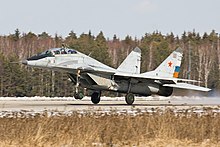


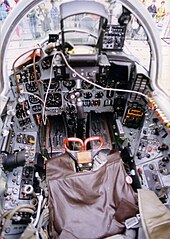

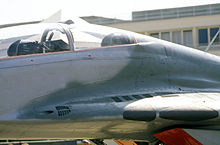

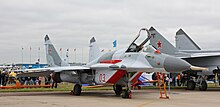






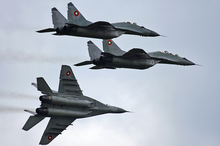





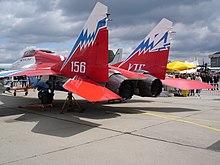





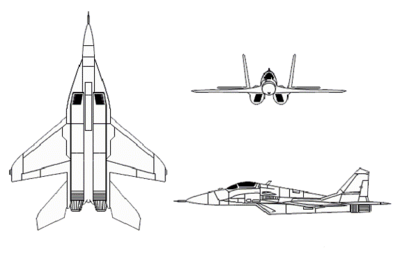
No comments:
Post a Comment